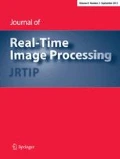In this first issue of volume 19 in 2022, I would like to begin by paying tribute to Dr. Matthias Carlsohn who shared the duties of editor-in-chief with me from the inception of the journal 16 years ago in 2006 till the end of last year 2021. He provided a great service to Journal of Real-Time Image Processing (JRTIP) and the real-time image processing community by applying his expertise to the day-to-day operation of the journal with many ups and downs in the reviewing process of submitted manuscripts. He exhibited dedication to the journal toward improving its stature. It was a pleasure to have him as a partner jointly founding and running the journal. The Springer management team made a decision at the end of last year to have a sole editor-in-chief rather than two editors-in-chiefs for reasons of their own. On behalf of myself and all the associate and advisory editors, I would like to deeply thank Dr. Carlsohn for his contributions to the journal in the last 16 years and wish him all the best in his future endeavors.
Starting this year in 2022, JRTIP is going to adopt a new publication model called Continuous Article Publishing (CAP). There is going to be a transition period in 2022 for this new model to be fully put in place. Some of the issues in 2022 including this first issue will include the Online-First articles which are already listed on the journal website. Then, the remaining issues will include Online-First articles that appear within a two-month duration. Similar to the old model, there will be a total of 6 issues in a year; but unlike the old model, there will be no backlog queue of Online-First articles waiting to appear in a print issue. It is important to point out that the impact factor would not get affected by adopting the CAP model since the impact factor computational approach has recently changed and it now includes online papers with DOIs. This first issue of volume 19 includes the oldest 16 Online-First articles.
As far as special issues are concerned, in the CAP model, special issues are named “Topical Collections”. As a result, the papers associated with a topical collection would appear as they get accepted under a listing for the topical collection. On the journal website, the guidelines for offering special issues have been updated to reflect the new model of topical collections.
One item worth mentioning is that all submitted manuscripts are passed through a similarity check by Springer based on the iThenticate checker and other tools. Manuscripts having text similarities with previous publications, even by the same authors, are normally rejected and not placed into the review pipeline. Therefore, authors are urged to pay a very close attention to this matter by making sure that no text similarities appear in their manuscripts before they submit them to JRTIP.
As a final item of this editorial, it is to be noted that Prof. Touradj Ebrahimi and Prof. Thomas Sikora have decided to step down from the advisory board of JRTIP. I greatly appreciate their service to JRTIP as members of the advisory board.
I would like to end this editorial by expressing my gratitude to authors, reviewers, editors, and Springer publication and management teams for their contributions to JRTIP in one way or another and wish them all a very good year in 2022.
Author information
Authors and Affiliations
Corresponding author
Additional information
Publisher's Note
Springer Nature remains neutral with regard to jurisdictional claims in published maps and institutional affiliations.
Rights and permissions
About this article
Cite this article
Kehtarnavaz, N. Journal of Real-Time Image Processing: first issue of volume 19. J Real-Time Image Proc 19, 1 (2022). https://doi.org/10.1007/s11554-022-01197-0
Published:
Issue Date:
DOI: https://doi.org/10.1007/s11554-022-01197-0

